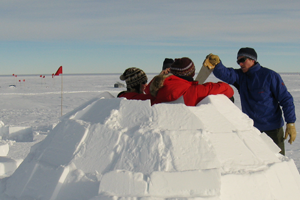Succesful season at WAIS Divide
A few weeks ago, drilling ceased for this season at WAIS Divide, Antarctica, at a depth of 1511.9 m. The goals of drilling through the brittle ice and down past 1500 m were met
By Susanne Lilja Buchardt
The ice core being drilled at WAIS (West Antarctic Ice Sheet) Divide can be considered a sister core to the ice cores from Central Greenland. The ice thickness, the annual snow accumulation and the annual temperature are similar for the two locations, and comparing data from similar sites on both hemispheres will lead to new detailed knowledge on climate behaviour during the last glacial cycle, i.e. the last 100,000 years.
Centre for Ice and Climate collaborates with the WAIS Divide team and last year Trevor Popp and Inger Seierstad from CIC participated in the 2007/2008 field campaign, while Susanne Lilja Buchardt (also CIC) was part of this year’s field crew.
The goal of the 2008/2009 field season was to drill through the brittle ice. In the upper part of an ice sheet the ice contains little bubbles of atmospheric air that was trapped when the snow was compressed to ice. As the ice get buried under the increasing burden of overlying snow and ice the pressure increases and eventually, the pressure in the bubbles is sufficient to cause the ice to spontaneously fracture when brought to the surface. At even greater depths the bubbles disappear (the air is pushed into clathrates, a different crystal structure) and the ice is no longer brittle.
 This year’s drilling started at the depth of 580 m where the ice was already becoming brittle and would break when rotated in the core trough or when cut with a saw. Therefore, the ice was not cut on the surface. Instead, the drillers would drill one meter of core, break and then instead of taking the drill to the surface they would lower it again and drill another meter of ice core. Thus, the ice core would come out of the drill already in sections of 1 m. The ice cores were pushed directly from the drill and into plastic netting that held fractured core tightly together. The core quality reached a minimum just short of 1100 meter’s depth and from there on things started to look better. At 1310 m the ice was no longer brittle, and the drillers started pulling up 2.5 m long pieces of ice core that were then cut into 1 m pieces at the surface. The final depth at the end of season was 1511.9 m and the age at this depth was estimated from DEP (dielectric properties) measurements to be 7693 years BP.
This year’s drilling started at the depth of 580 m where the ice was already becoming brittle and would break when rotated in the core trough or when cut with a saw. Therefore, the ice was not cut on the surface. Instead, the drillers would drill one meter of core, break and then instead of taking the drill to the surface they would lower it again and drill another meter of ice core. Thus, the ice core would come out of the drill already in sections of 1 m. The ice cores were pushed directly from the drill and into plastic netting that held fractured core tightly together. The core quality reached a minimum just short of 1100 meter’s depth and from there on things started to look better. At 1310 m the ice was no longer brittle, and the drillers started pulling up 2.5 m long pieces of ice core that were then cut into 1 m pieces at the surface. The final depth at the end of season was 1511.9 m and the age at this depth was estimated from DEP (dielectric properties) measurements to be 7693 years BP.
The 931.9 m of ice core drilling this season will now overwinter at WAIS Divide. After a few months on the surface the ice will be less brittle and thus easier to handle without breaking. In the beginning of next season they will be packed and shipped to the US where samples of the ice will be cut and measured.
During most of the season the weather was very nice – sunshine, little or no wind, and  temperatures between -10C and -20C. This made some very entertaining spare time projects like igloo building possible.
temperatures between -10C and -20C. This made some very entertaining spare time projects like igloo building possible.
Read more about the WAIS Divide project at www.waisdivide.unh.edu and the NEEM project at www.neem.ku.dk
